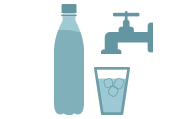Resources in Your Region

A variety of factors are taken into account in determining the quality of water for safety and health standards.
You can get some important details on various aspects of water quality in your area from these helpful websites:
United States Environmental Protection Agency (EPA):
U.S. Food & Drug Administration (FDA):


How to Read a Water Quality Report
Public or community water systems are required to provide a drinking water quality report to its customers on an annual basis. These reports (also known as consumer confidence reports-CCR), which EPA developed in consultation with water suppliers, environmental groups, and the states, enable Americans to make practical, knowledgeable decisions about their health and their environment. Many bottled water companies also provide a water quality report to their consumers. These reports can be distributed through a variety of means including printed publications, internet, postings and direct contact. They help people make informed choices about the water they drink, and let them know what contaminants if any, are in their drinking water or bottled water. CCRs also give the public water system a chance to tell customers what it takes to deliver safe drinking water and how contaminants may affect their health.
Some public water systems may be exempted from certain testing requirements. Also, public drinking water may be allowed under EPA regulations to exceed the MCL’s for certain contaminants under special conditions. Should public water systems exceed an EPA MCL, they must notify their customers of that exceedance. Additionally, public drinking water that exceeds the microbiological standard for coliform and e coli is required to issue a boil water alert to its customers for health and safety purposes. Bottled water may not exceed the MCL for any contaminants under any condition. A recall is required on all affected bottled water product if an MCL is exceeded.
The EPA has a site that provides greater details on Consumer Confidence Reporting. It can be found at: https://www.epa.gov/ccr. While the EPA regulates public water supplies as a utility, the FDA regulates bottled water as a food product. Public water systems must meet EPA Drinking Water Standards as established under the EPA Safe Drinking Water Act (SDWA). Bottled Water must meet the FDA Bottled Water Regulations and through the SDWA also meet EPA Drinking Water Standards.
Understanding Water Quality Terms
Water quality reports use terms that help to define and report on the presence or absence of contaminants, substances or physical parameters. Common to both bottled water and public drinking water are the terms:
Because typical public drinking water systems treat surface water with best available methods, they may also report in terms such as:
